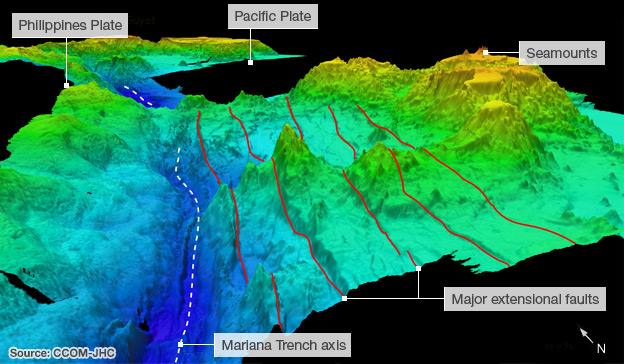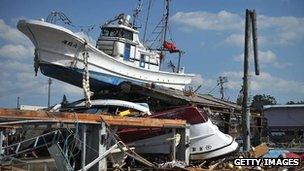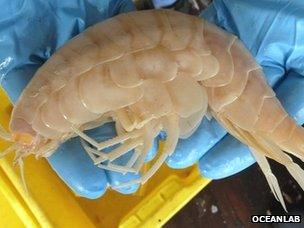Race to the bottom of the ocean: Why go down?
- Published
As a new wave of explorers reach the deepest part of the ocean, researchers too are realising the scientific potential that lies at the bottom of the sea, writes science reporter Rebecca Morelle.

Stretching for more than 2,500km (1,500 miles), the Mariana Trench is a very narrow, very deep crack in the ocean floor.
At its deepest, it reaches nearly 11km (seven miles) down - making it the lowest point in our oceans.
Once, its record-breaking depth was thought to be the only interesting thing about the trench, but now scientists are beginning to think otherwise.

Seismic activity in the deep ocean may have caused the earthquake and tsunami that hit Japan in 2011
Jim Gardner, from the US Centre for Coastal and Ocean Mapping (CCOM), says: "Trenches are becoming much more focused in the scientific community."
The geologist has spent the past five years creating the most detailed survey of the Mariana Trench to date.
And he says that finding out more about the inner workings of these deep-sea spots is vital.
There are more than 20 trenches like the Mariana around the world, but most are in the Pacific Ocean.
They are formed at the boundary of two tectonic plates, where very heavy oceanic crust (in the case of the Mariana Trench, the Pacific Plate) dives underneath lighter continental plate - a process called subduction.
But geologists now think these seismically active zones could play a central role in some earthquakes.
Dr Gardner explains: "It's where the two tectonic plates are grinding together.
"So seamounts (underwater mountains) that rest passively on the top of the Pacific Plate get jammed underneath in the trench or scraped up on the inner wall.
"And if they get jammed underneath, some theories suggest that they cause the big major earthquakes, like the recent ones in Japan or Indonesia."
Gelatinous creatures
Biologists are also shedding light on the deep ocean.
Dr Alan Jamieson, from Oceanlab at the University of Aberdeen, has been using simple contraptions to explore the bottoms of trenches.
He uses steel, tripod-shaped landers that are kitted out with cameras and then loads them up with some bait.

The "supergiant" amphipods were found 7,000m down in the Kermadec Trench
They then drop to to the bottom of the ocean, where they sit for hours recording any creatures tempted by an easy meal.
"When we started this, we thought that anything we did find would be in relatively low numbers, probably pale in colour and just trying to eke out an existence in the deep," says Dr Jamieson.
"But we have found lots of activity even at the very deepest sites."
With this set up, he has been able to record a remarkable array of life, from amphipods - prawn-like creatures that can reach more than 30cm (12in) long - to bright pink, gelatinous fish.
He is now studying the physiology of these creatures to find out how they can survive in a place where the pressure is 1,000 times greater than at sea level, the temperature is just above 0C, and they are shrouded in total darkness.
Carbon sink
But if the life that is found in the deep is of interest, so is what happens as it dies.
As the organic matter from dead marine flora and fauna sinks to the bottom of the sea, it is hemmed in by the steep walls of the trench.
A study published last year found that because of this, more carbon accumulates at the bottom of trenches than in other parts of the ocean.
And this suggests that the deep sea might play a bigger role in the carbon cycle, and therefore in regulating the Earth's climate, than was previously thought.
Researchers are now trying to find out how much carbon is sinking - or being "subducted" - beneath the sediment and how much is being recycled by bacteria to assess how much carbon is being taken out of the atmosphere.
But although scientists are starting to unlock the secrets of the deep, oceanographer Sylvia Earle says there is still much work to do.
"I'm sad to say that here we are at the beginning of the 21st Century, and we know more about other parts of the Solar System than we do our own ocean.
"We have better maps of the Moon, Mars and Jupiter than we do about our own ocean floor," she says.
Man or machine?
She believes the very deepest parts of the ocean have been the most neglected.
Most of the sea floor lies between 4,000m and 6,000m (13,000-20,000ft) below sea level: a layer known as the abyssal zone. But trenches, although few in number, are twice as deep, and they occupy an area called the Hadal Zone.

Unmanned submersibles such as Nereus give researchers a risk-free way to explore the deep
She says: "That last little bit only accounts for maybe 3% of the ocean. Well think about it - that's an area the size of Australia, North America, or China - and we're ignoring it?"
Dr Earle is the former science chief for the National Oceanic and Atmospheric Administration - or Noaa - the ocean's equivalent of the US space agency, Nasa.
But she is frustrated that the seas have always been the poor relation to space.
She explains: "A fraction of what we invest in going skyward would answer some major questions about this part of the Solar System."
There is currently some debate within the scientific community over the best way to explore the deepest parts of the ocean.
Some researchers, such as Dr Earle, believe that manned missions are the only way to really get a grasp of what lies in this underwater world.
Others though say that landers and a new breed of autonomous underwater robots, such as Nereus at the Woods Hole Institute for Oceanography in Massachusetts, can bring back much more data.
Dr Jamieson thinks unmanned exploration is the way forward for science. But he does hope that the publicity surrounding the forthcoming dives might generate some excitement and interest in the oceans.
He says: "Any kind of high-profile event would be fantastic, we hope this will raise the profile of the trenches.
"The trenches have always suffered from this kind of anthropocentric opinion: that the further away it is from human activity it is the less important it is, that it's just some kind of deep, dark realm that could be ignored.
He adds: "But the fact is, the more we look at it, the more we find the trenches are just as relevant as anywhere else in the ocean.
"And ultimately, ocean conservation is everything, from the surface to the very deepest point."
- Published7 December 2011
- Published2 February 2012
- Published14 March 2012
- Published24 June 2011
- Published6 April 2011
- Published17 January 2011
- Published8 September 2010